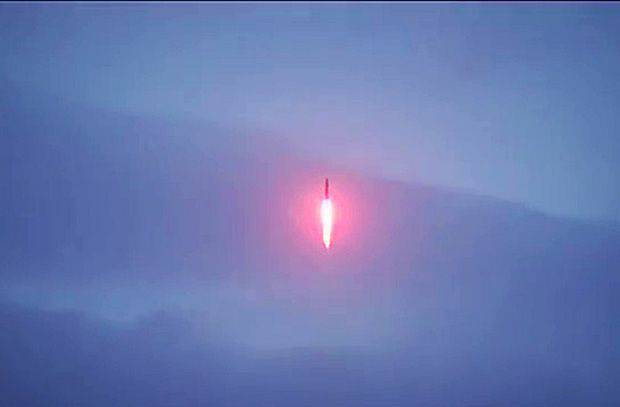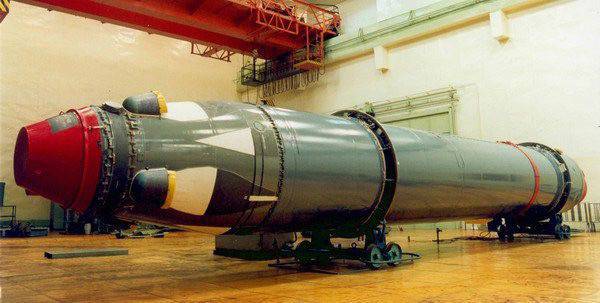Russian "Blue" against the American "Trident"

The Sineva submarine-launched ballistic missile surpasses the American counterpart Trident-2 in a number of characteristics
The successful, already 27th launch on December 12 of the Sineva ballistic missile from the strategic nuclear submarine Verkhoturye confirmed that Russia has weapon retribution. The missile covered about 6 km and hit a mock target at the Kamchatka Kura training ground. By the way, the Verkhoturye submarine is a deeply modernized version of the Project 667BDRM nuclear submarines of the Dolphin class (Delta-IV according to NATO classification), which today form the basis of the naval forces of strategic nuclear deterrence.
For those who zealously follow the state of our defensive capabilities, this is not the first and rather familiar message about the successful launches of the Sineva. In the current rather alarming international situation, many are interested in the question of the capabilities of our missile in comparison with the closest foreign analogue - the American missile UGM-133A Trident-II D5 ("Trident-2"), in everyday life - "Trident-2".
Icy "Blue"
The R-29RMU2 Sineva missile is designed to destroy strategically important enemy targets at intercontinental ranges. It is the main armament of the Project 667BDRM strategic missile cruisers and was created on the basis of the R-29RM ICBM. According to NATO classification - SS-N-23 Skiff, according to the START treaty - RSM-54. It is a three-stage liquid-propellant intercontinental ballistic missile (ICBM) of the third generation sea-based submarine. After being put into service in 2007, it was planned to release about 100 Sineva missiles.
The launch weight (payload) of the Sineva does not exceed 40,3 tons. The multiple warhead of an ICBM (2,8 tons) at a range of up to 11 km can deliver, depending on the power, from 500 to 4 individually targetable warheads.
The maximum deviation from the target when starting from a depth of up to 55 m does not exceed 500 m, which is ensured by an effective on-board control system using astro-correction and satellite navigation. To overcome the anti-missile defense of the enemy, the Sineva can be equipped with special means and use a flat flight path.
These are the main data of the Sineva ICBM, known from open sources. For comparison, we present the main characteristics of the American missile "Trident-2", which is the closest analogue of the Russian "underwater" sword.

American "Trident" - "Trident-2"
The Trident-2 solid-propellant intercontinental ballistic missile was put into service in 1990. It has a lighter modification - "Trident-1" - and is designed to defeat strategically important targets on enemy territory; in terms of tasks to be solved, it is similar to the Russian "Sineva". The missile is equipped with the American submarines SSBN-726 of the Ohio class. In 2007, its mass production was discontinued.
With a launch weight of 59 tons, the Trident-2 ICBM is capable of delivering a payload weighing 2,8 tons to a distance of 7800 km from the launch site. The maximum flight range of 11 km can be achieved by reducing the weight and number of warheads. As a payload, the missile can carry 300 and 8 medium (W14, 88 kt) and low (W475, 76 kt) individually targetable warheads, respectively. The circular probable deviation of these blocks from the target is 100–90 m.
Comparison of the characteristics of the Sineva and Trident-2 missiles
In general, the Sineva is not inferior in its main characteristics, but surpasses the American Trident-2 ICBM in a number of ways. At the same time, our rocket, unlike its overseas counterpart, has a great potential for modernization. In 2011, it was tested and in 2014 a new version of the rocket, the R-29RMU2.1 Liner, was put into service. In addition, the modification of the R-29RMU3, if necessary, can replace the Bulava solid-propellant ICBM.
Our "Sineva" is the best in the world in terms of energy-mass perfection (the ratio of the mass of the combat load to the launch mass of the rocket, reduced to one flight range). This indicator of 46 units significantly exceeds that of the Trident-1 (33) and Trident-2 (37,5) ICBMs, which directly affects the maximum flight range.
"Sineva", launched in October 2008 from the Barents Sea by the nuclear submarine "Tula" from a submerged position, flew 11 km and delivered a model of the warhead to the equatorial Pacific Ocean. This is 547 km higher than that of Trident-200. No missile in the world has such a range margin.
In fact, Russian strategic missile submarines are capable of shelling the central states of the United States from positions directly off their coasts under the protection of surface fleet. You can say without leaving the pier. But there are examples of how an underwater missile carrier carried out a covert, “under-ice” launch of the Sineva from the Arctic latitudes with ice up to two meters thick in the North Pole region.
The Russian intercontinental ballistic missile can be launched by a launch vehicle moving at a speed of up to five knots, from a depth of up to 55 m and a sea state of up to 7 points in any direction along the course of the ship. ICBM "Trident-2" at the same carrier speed can be launched from a depth of up to 30 m and waves up to 6 points. It is also important that immediately after the start, the Sineva steadily reaches a given trajectory, which the Trident cannot boast of. This is due to the fact that the Trident is launched by a pressure accumulator, and the submarine commander, thinking about safety, will always make a choice between an underwater or surface launch.
An important indicator for such weapons is the rate of fire and the possibility of volley fire in the preparation and conduct of a retaliatory strike. This significantly increases the likelihood of breaking through the enemy's missile defense system and inflicting a guaranteed defeat on him. With a maximum launch interval between Sineva ICBMs of up to 10 seconds, this figure for Trident-2 is twice (20 s) higher. And in August 1991, a salvo launch of ammunition from 16 Sineva ICBMs was carried out by the Novomoskovsk submarine, which to date has no analogues in the world.
Our "Sineva" is not inferior to the American missile in the accuracy of hitting the target when equipped with a new medium-power block. It can also be used in a non-nuclear conflict with a high-precision high-explosive fragmentation warhead weighing about 2 tons. To overcome the enemy's missile defense system, in addition to special equipment, "Sineva" can fly to the target and along a flat trajectory. This significantly reduces the likelihood of its timely detection, and hence the likely defeat.
And one more important factor in our time. For all its positive performance, Trident-type ICBMs, we repeat, are difficult to modernize. For more than 25 years of service life, the electronic base has changed significantly, which does not allow local modernization of modern systems in the rocket design at the software and hardware levels.
Finally, another plus of our "Sineva" is the possibility of its use for peaceful purposes. At one time, the Volna and Shtil carriers were created to launch spacecraft into low earth orbit. In 1991-1993, three such launches were carried out, and the conversion "Sineva" entered the Guinness Book of Records as the fastest "mail". In June 1995, this rocket delivered a set of scientific equipment and mail in a special capsule to a range of 9000 km, to Kamchatka.
As a result: the above and other indicators became the basis for German specialists to consider Sineva a masterpiece of naval rocket science.
Information